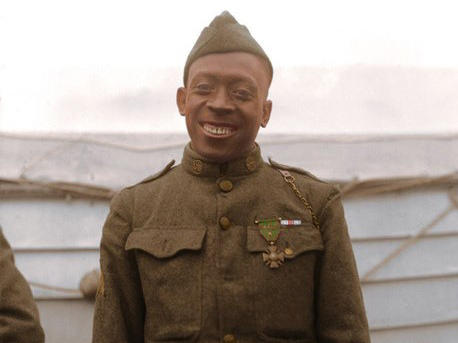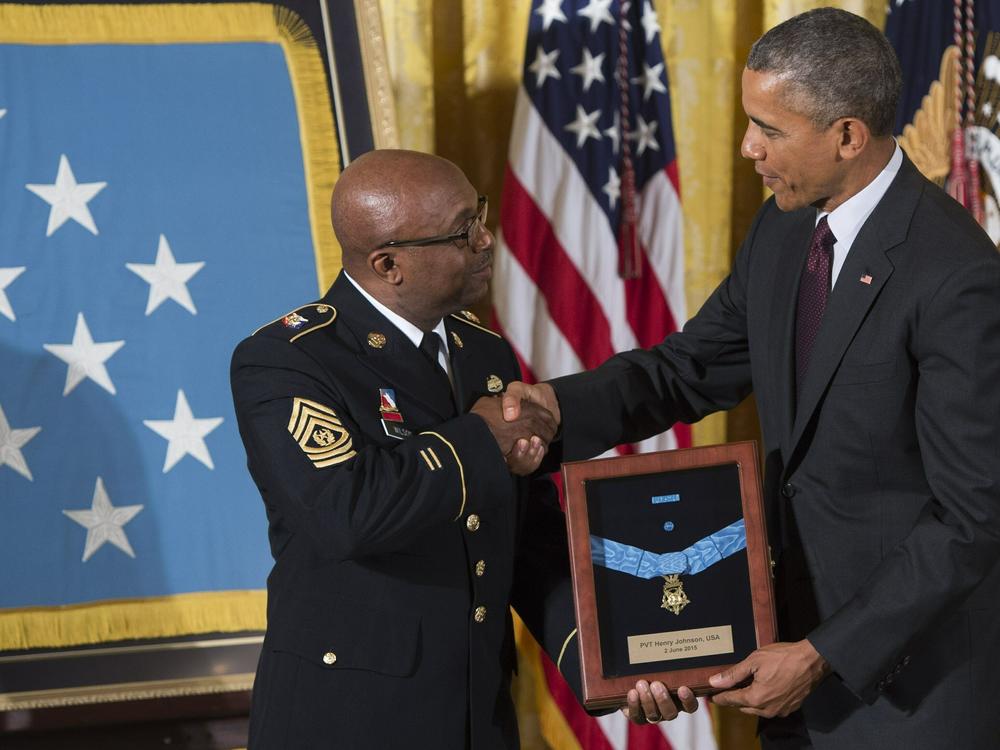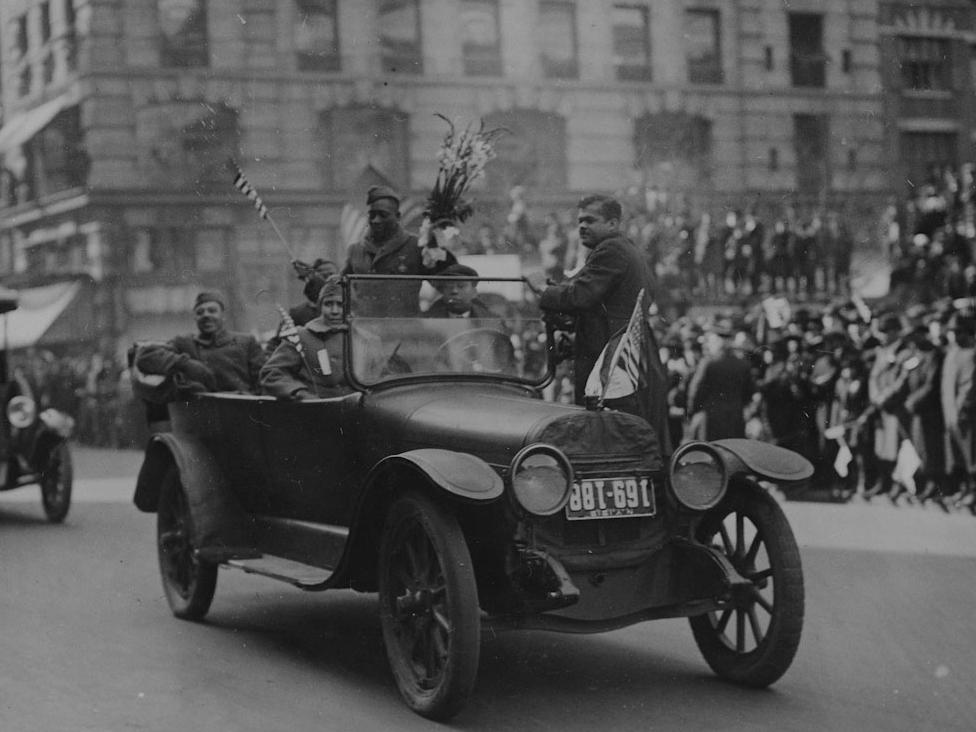Section Branding
Header Content
The U.S. Army renames a base in honor of Sgt. William Henry Johnson, a Black WWI hero
Primary Content
Louisiana's Fort Polk became the latest U.S. Army installation to shed its Confederate namesake on Tuesday when it was officially renamed Fort Johnson after a Black World War I hero.
The base now honors Sgt. William Henry Johnson, whose actions on the front lines in France earned him the nickname Black Death during his lifetime and a posthumous Medal of Honor nearly a century later.
"The Warrior Spirit that burned with in Sgt. William Henry Johnson now inspires generations of Soldiers — Soldiers that will now call JRTC and Fort Johnson home and Soldiers that will continue to come here from all over the nation and the world to train," said Brig. Gen. David Gardner, commanding general of Joint Readiness Training Center and Fort Johnson, in a Facebook post.
Johnson's courage became the stuff of legend after the night of May 15, 1918, when he nearly single-handedly stopped German forces from approaching the main French line and taking his fellow soldier prisoner in the process.
He maintained a fierce defense during the surprise attack, continuing to fight even after being injured by enemy fire and running out of ammunition. Johnson turned to hand-to-hand combat and his bolo knife, eventually killing four German troops and wounding between 10 and 20 others, according to the National Museum of the United States Army.
"By the time what a reporter called 'The Battle of Henry Johnson' was over, Johnson had been wounded 21 times and had become the first American hero of World War I," says the U.S. Department of Defense.
Johnson and his comrade Pvt. Needham Roberts became the first U.S. soldiers to receive the Croix du Guerre — France's highest military honor — as a result of their actions, and later returned home as national heroes.
Johnson led the 369th victory parade through New York City in 1919, and former President Theodore Roosevelt called him "one of the five bravest American soldiers in the war." Johnson was more modest in his own assessment.
"There wasn't anything so fine about it," he said later. "Just fought for my life. A rabbit would have done that."
Upon returning home Johnson was sent on a speaking tour and lauded for his courage. His image was even used to recruit soldiers and sell Victory Stamps.
But he was "shunted aside" after describing the unfair treatment of Black American soldiers, according to the National Guard.
And, despite the public praise, the Army denied Johnson recognition for his actions in many key ways. Among them, it didn't mention his debilitating injuries in his discharge records or grant him a disability allowance.
Johnson's combat injuries and lack of education prevented him from holding a steady job and fully returning to civilian life in the years after the war. He was reportedly destitute when he died of myocarditis at the age of 32 in 1929.
"Johnson's meritorious service in the face [of] prejudice and discrimination contributed to the Allied victory in World War I," the Army museum says. "Yet, recognition for that service did not come quickly."
The U.S. posthumously awarded him a Purple Heart in 1996 and the Distinguished Service Cross in 2002. Then-President Barack Obama awarded Johnson the Medal of Honor in 2015, nearly 100 years after that dramatic night on the battlefield.
"We have work to do as a nation to make sure that all of our heroes' stories are told," Obama said during the ceremony. "The least we can do is to say, 'We know who you are, we know what you did for us. We are forever grateful.'"
Johnson's segregated unit made it to the front lines
Johnson was born in Winston Salem, N.C., in 1892 and moved as a teenager to Albany, N.Y., where he held a series of jobs including chauffeur, soda mixer, laborer and train station porter.
Johnson — at 5'4" and 130 pounds — enlisted in the Army in June 1917, just two months after the U.S. entered WWI.
He was assigned to Company C, 15th New York (Colored) Infantry Regiment, an all-Black unit of the New York National Guard. It was federalized, renamed the 369th Infantry Regiment — also known as the Harlem Hellfighters — and deployed to Europe.
And while the segregated U.S. Army relegated Black soldiers to manual labor and other non-combat roles, the French Army was willing to work with them as infantrymen.
The 369th Regiment ended up integrating with the French 161st Division and deploying to a position near the Argonne Forest in northeastern France. Those first few weeks on the frontlines were relatively uneventful — until the night of May 15.
Outnumbered and out of equipment, he persevered
Johnson and Roberts were on night patrol when they heard the sound of gunshots and wire cutters, alerting them to the presence of at least a dozen German soldiers preparing for a surprise raid.
Johnson stalled the Germans by throwing grenades until he ran out. They returned fire, badly injuring Roberts.
Johnson then picked up his French rifle, which carried only three cartridges. Arthur Little, the 1st Battalion commander, described the scene in his 1936 book From Harlem to the Rhine.
"Johnson fired his three shots — the last one almost muzzle-to-breast of the German bearing down upon him," he wrote. "As the German fell, a comrade jumped over his body, pistol in hand, to avenge his death. There was no time for reloading. Johnson swung his rifle round his head, and brought it down with a thrown blow upon the head of the German. The German went down, crying."
That's when Johnson noticed some of the soldiers lifting Roberts up, presumably to take him back over enemy lines. He drew his bolo knife, the last of his weapons, and charged at the German soldiers even as they kept shooting at him.
"He killed one German with rifle fire, knocked one down with clubbed rifle, killed two with bolo, killed one with grenade, and, it is believed, wounded others," read the New York National Guard annual report of 1920.
Johnson's "frantic attacks broke the German morale and the enemy raiding party retreated," the Army museum says. He is credited with holding the Germans back from the French line and saving Roberts from capture.
Johnson "displayed the most profound battlefield bravery in World War I, yet for almost a century the nation for which he was willing to give his life shamefully failed to recognize his heroics," Senate Majority Leader Chuck Schumer, a longtime advocate of the renaming, said in a Wednesday statement.
Tuesday's change, he added, ensures that Johnson's legacy will endure.
The Harlem Hellfighters made many contributions to the war
Johnson and Roberts' efforts also boosted the "vigilance and confidence" of the 369th regiment itself.
The honors they received were the first of many for the Harlem Hellfighters, who spent over 191 days in the front-line trenches (more time in continuous combat than any other American unit of its size) and suffered more than 1,400 casualties (more losses than any other American regiment).
And, in a major non-combat contribution, the infantry's band is credited with introducing jazz music to European audiences.
After the war, France awarded the Croix de Guerre medal to 171 members of the regiment, as well as a Croix de Guerre citation to the unit as a whole. Their heroism was recognized in the U.S. at the end of the war, too — even though they were largely forgotten in the decades after it.
"The Harlem Hellfighters were the first New York combat unit to return home, and the regiment, which had been denied a place in the farewell parade the prior year, was rewarded with a victory parade," according to the National Museum of African American History and Culture.
That's the parade that Johnson led. He rode in a convertible instead of marching, due to the metal plate in his foot.
Newspapers reported at the time that he was so moved he stood up, clutching lilies from admirers and bowing to the crowds that were chanting his name — a name that will likely mean something to many more people after this week.
Copyright 2023 NPR. To see more, visit https://www.npr.org.



